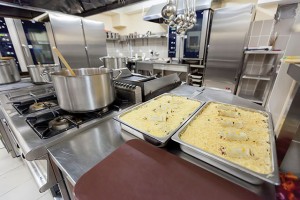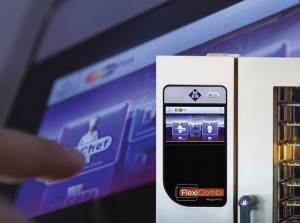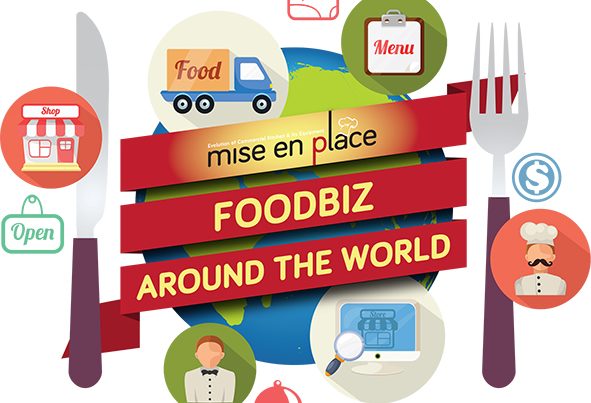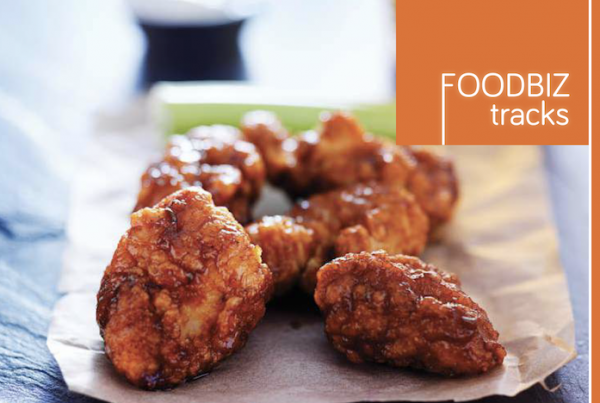“A task carried out by institutional kitchens, it is defined as bulk preparation and cooking for a group that does not consider the specific preferences of an individual.”
(R.H.G. Charles. Mass Catering; WHO Regional Office for Europe, 1983)
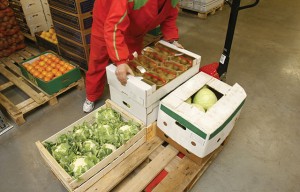 That is the basic definition of mass catering but today’s advancement in technology has enabled customers to choose even though the kitchen is dishing out 500 servings at once; many hotels that serve multiple course meals to huge groups are able to offer diners selection, at least of their main course. However, the execution of mass catering begins not at the point of cooking but the planning. Although theoretically, you want food to be prepared upon order, giving you a sense of freshness but when it comes to businesses cooking for hundreds of people such as in factories, educational institutes, hospitals or military camps or even in banquet dinners – it would only make sense that major planning was in the works when 1000 diners get to eat at the same time.
That is the basic definition of mass catering but today’s advancement in technology has enabled customers to choose even though the kitchen is dishing out 500 servings at once; many hotels that serve multiple course meals to huge groups are able to offer diners selection, at least of their main course. However, the execution of mass catering begins not at the point of cooking but the planning. Although theoretically, you want food to be prepared upon order, giving you a sense of freshness but when it comes to businesses cooking for hundreds of people such as in factories, educational institutes, hospitals or military camps or even in banquet dinners – it would only make sense that major planning was in the works when 1000 diners get to eat at the same time.
 Therefore, in this issue, we try to grasp a sense of how kitchens are set up to dish out high volumes of food. Normally the mealtime or presentation of food is often fixed for everyone or depending on the governance; dining intervals can be according to shifts. Most of the time, the kitchen is streamlined based on dining times, location and food options for the high number of people. Detailed planning such as labour management and cost efficient practices in purchasing on top of a standardised portion control during service would help to reduce food waste.
Therefore, in this issue, we try to grasp a sense of how kitchens are set up to dish out high volumes of food. Normally the mealtime or presentation of food is often fixed for everyone or depending on the governance; dining intervals can be according to shifts. Most of the time, the kitchen is streamlined based on dining times, location and food options for the high number of people. Detailed planning such as labour management and cost efficient practices in purchasing on top of a standardised portion control during service would help to reduce food waste.
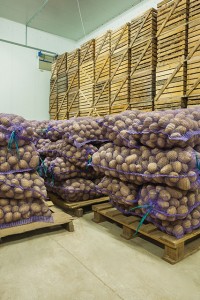 As each kitchen is built differently according to its purpose and space, the foundational requirement is to design a logical flow of materials from raw to the finished cooked item to avoid cross-contamination. Look into the location of the kitchen as well according to the facility’s type of operation. For example, a hospital’s kitchen must be far from the wards to keep the noise, cooking odours and fumes out and in factories where processes produce fumes, the kitchen must be fitted with necessary measures to keep the fumes from contaminating food.
As each kitchen is built differently according to its purpose and space, the foundational requirement is to design a logical flow of materials from raw to the finished cooked item to avoid cross-contamination. Look into the location of the kitchen as well according to the facility’s type of operation. For example, a hospital’s kitchen must be far from the wards to keep the noise, cooking odours and fumes out and in factories where processes produce fumes, the kitchen must be fitted with necessary measures to keep the fumes from contaminating food.
According to Mr Rick Chee of F&B Facilities, his experience in building army camp kitchens in Malaysia led him to the insight that one must also know the feeding strength of the people patronising your kitchen and the amount of space for things like drainage or bain-marie placement to maintain warm temperatures of the food in their trays. Citing army camps that are huge with many divisions, a Central Production Unit (CPU) and satellite kitchens make sense as the CPU will send the cooked food to each satellite for reheating, service and washing which reduces the cost for operating numerous kitchens. As for hospital kitchens, it is also about the number of beds but in terms of menu, it would be more diversified based on the diet of patients in each ward but all the cooking is still done in one kitchen. While the design or service type of institutional kitchens vary, the basic principles to consider adhering to include:
PURCHASING AND PLANNING
There is no approved guide for this as no large kitchens are the same and how the head prefers to manage it also differs. The type of menu would need to be first determined and large companies that provide meals at the workplace go by “at work menus” or referenced as a “cyclical menu” that is compiled in advance and runs a specific length of time. The kitchen team can compile, for example, 10 menus and rotate it over 12 months and some caterers apply this method because it saves time and if Menu A and Menu F has the same item, it can be cooked as one batch and kept frozen for the following cycle. It involves bulk purchase that means better cost control and cooking more at once makes time and labour management more efficient as well. Note that this menu type should be rotated on the regular especially if a kitchen serves the same people daily so that the clientele experiences variety. When it comes to purchasing, there should be a ‘storekeeper’ who is put in charge to update what needs to be stocked up and he or she be made the sole contact point for suppliers, chefs or management to avoid confusion.
STORAGE
When food items are bought in large amounts, it is possible that stocks brought in at one time are meant to last over a period and therefore must be stored correctly. Placing dry and canned items on shelves with labels is the easiest way for the team to quickly find something while separate sections can comprise of various sections like cold rooms, fridges and deepfreezers. Always bring the older stock to the front during replenishment and avoid putting strong smelling items with those that absorbs smells easily such as cheese and eggs. If you receive items in flimsy bags, transfer them to containers with tight fitting lids and commodities in sacks cannot be kept directly on the floor but on a raised platform to permit air circulation and prevent pests from the floor from making their way in through the bottom.
Food still frozen at the point of delivery must be immediately transferred to the deep freezer while the cold room is a separate entity to store fresh meat and poultry for a short period. Fish and seafood must be kept separately so it does not affect other foods. Note that a chill room is different than a cold one as it keeps food like dairy items, fruits, vegetables and dessert items at a temperature they are comfortable enough in.
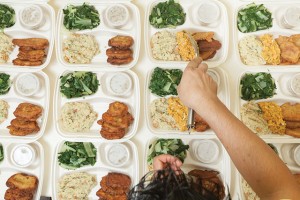 PREPARATION AND COOKING
PREPARATION AND COOKING
The need to serve so many people at once means advanced preparation and cooking to ensure punctuality of meal delivery to customers; however it bears the risk of contamination from improper storage. Cooked food must be kept at 60°C for safe consumption and regular room temperature would not cut it. To overcome the stress of cooking as close to serving time as possible, many large kitchens employ the cook-chill system which is based on normal cooking of food which is then chilled rapidly and reheated before consumption. In room temperature, enzymic and chemical reactions cause food to deteriorate rapidly and although it is unlikely to taste bad, the reactions taken place is adequate to cause food poisoning. Cook-chilling prolongs the storage life of the food by being chilled down in a blast chiller to 0°C- 3°C within 1.5 hours of leaving the cooking pan.
Although most pathogenic organisms are unlikely to manifest below 7°C, a temperature of 3°C is the standard to reduce growth of spoilage organisms but bear in mind that this temperature is not considered a safe zone yet therefore food cannot be stored longer than 5 days. Cooked-chill items should be regenerated immediately to at least 70°C upon coming out from its chilled conditions and consumed within two hours and discarded otherwise. Also basic items like stock and sauces, look at your menus for the week and you can reduce repetitive cooking by having them prepared all at the same time. By doing so, you can also reduce not only the cooking and preparation time but also unnecessary movement in your purchase and storage activity.
 DISTRIBUTION / SERVICE
DISTRIBUTION / SERVICE
If the food needs to be distributed around the building, a warm holding cabinet would be required to keep the temperature stable so foods’ texture and palatability is not affected. The transportation method used must be able to maintain food at 3°C throughout the distribution process. It is still safe to eat if it exceeds 10°C because the food has been kept in a warm holding cabinet which is most applied by hospitals as meals are often ‘traveling’ a certain distance from the kitchen to each floor.
In a large hospital, it could end up being more expensive to have holding cabinets for delivery and Mr Chee asks; can a ‘dumb waiter’ system be constructed where food is sent to each floor where a pantry area is provided with one warm holding cabinet to distribute the food; instead of deploying many staff to carry out the task? For self-service arrangements, food is placed at the dining area and kept warm with bain-maries or in appropriate salad bar and/or deli tables.
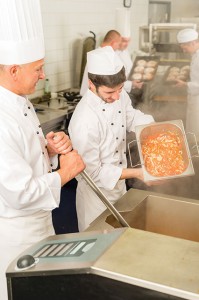 EQUIPMENT
EQUIPMENT
For large kitchens, the equipment plays an important role. When you need to cook a few hundred kilograms of any 1 item of raw food, your investment into the equipment would be your most important decision. Whether equipment for storing raw food, holding cooked food or the cooking tool, a break down would mean a huge loss in terms of the food items and of course the upkeep of the equipment. Modern equipment has improved leaps and bounds – many can be remotely controlled and have the same process configured to be replicated for multiple machines at the same time with just the transfer of data using a thumbdrive. Some equipment allows the chefs to operate without having to supervise or oversee the process all the time, up till the ability of overnight cooking. Read some examples and options of equipment that you can consider in our review in page 51.
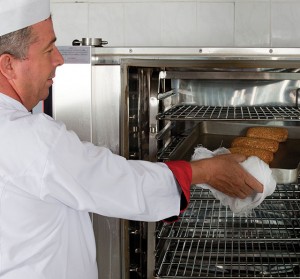 LABOUR
LABOUR
In a mass catering kitchen, staffs are usually employed to work regular times instead of erratic shift hours which might be an advantage in terms of hiring. As equipment are made to meet the high capacity cooking, there is lesser need for the entire crew to be exceptionally skilled and experienced in the science and expertise of cooking but can be trained to operate the automated machinery. In its beginning, mass catering was (and still is) to meet the eating requirements of the large crowd in a central location. It was also sensible and more efficient to do so for many facilities to employ this type of service. Today, the industry has flourished and we can say that it can now mean any kitchen that caters to thousands of people at one go. This definition extends to the hospitality sector as well where kitchens of leisurely places are commissioned to serve more people than ever before. Next, we spoke to Chef Kenneth Francisco of Resorts World Sentosa, Singapore who shared his experience of cooking for the masses in various capacities through his career.
Our appreciation to Mr Rick Chee
for his time and knowledge in
realising this article.
Reference:
R.H.G. Charles. Mass Catering; WHO Regional Office for Europe, 1983
Ronald Kinton & Victor Caserani. The Theory of Catering


